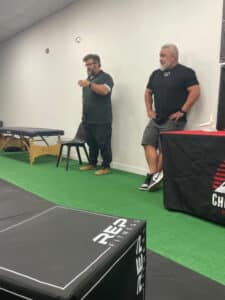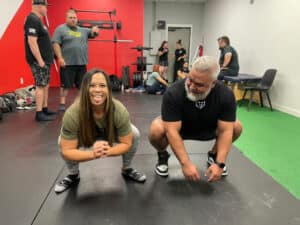What a great time going over the squat! John Mazza can go all out and get deep into how he gets into squats (pun intended). While I, Dr. Bird focused on a deep anatomical approach with hopes at improving your preparedness for the squat.
We are going to discuss here a few of the things that we went over for the squat. 
The squat is a beautiful movement that when performed with optimal form can produce muscular power that rivals most other lifts. One squat does not necessarily fit all, but there are key components that should be given vital attention when it comes to your squat. It is a movement that includes both stability, mobility, core function, and balance. It requires a stable foot/ankle and a great mobile hip.
At the squat clinic we focused primarily on three areas: The ankle, hip, and trunk stability. It would have been great to have had time to cover all parts of the body and possible issues with the squat.
The reason we focused so much on those three areas is because it’s where most issues are seen during a squat – Not injuries or musculoskeletal conditions, but rather issues of function within those three areas. The foot/ankle, hip, and core need to be tacked down before the squat can be optimally or maximally efficient. A more efficient squat becomes a simpler pattern to build.
THE FOOT
The foot is where most work starts – as it’s what contacts the ground. The skill of understanding rooting and having the ability to solidify your foot with ground produces an increased force from the ground up through your kinetic chain, which allows you to feel more solid in each rep. We went over how to do this during the clinic, as well as provide you with the information via video links to do this well. A practice at improving your foot’s rooting ability can be done by placing the barbell on your back, unracking the bar and making a conscious effort at focusing on the ground and how to plant the foot better into the ground.
We spoke about the importance of ankle dorsiflexion for achieving adequate depth in the squat. There are some people that cannot naturally attain this due to changes seen in the bony architecture via injury or other abnormalities like tarsal tunnel syndrome (a boney fusion that should have separated at birth). Other issues can or do arise as we see surgical interventions have been required from previous injury. There are some things that you just cannot avoid, and become a limiter during the squat pattern.
As we continued up the body, the knee was skipped for the reason that its function during the squat is to be stable during flexion and extension. There are of course times where knee pain and/or limited range of motion will affect your power output and efficiency. This is another rabbit hole for another time, but for this workshop we decided to focus on the bigger movers and drivers.
THE HIP
The hip being one of the most mobile joints in the body can allow for a variety of movements and patterns within the squat alone. I briefly discussed some of the anatomical differences in the femur or hip socket that may change/alter mechanics for the squat. One person may be more apt to a wider stance for their squat while others are built more for a conventional or narrow stance. It is my belief that both are patterns that can be trained but one will feel the most natural to the athlete. What feels better to the athlete may be determined by the pelvis/hip rather than a coach or trainer suggests. Again this can be a grey area where testing both is going to be helpful.

THE TRUNK
From there we worked up to the trunk and torso, focusing on the ability to breath and brace. Most lifters will use a belt to help brace into for their lifts. An issue we see is an under-utilization of the torso musculature when wearing a weight belt. John Mazza and I did go over this in a video on youtube. Rest of the seminar was focused on incorporating a better brace into the trunk muscles to decrease low back movement during the squat. The squat is a very technical movement that when done well can be an efficient movement at building strength and power.
Again we are grateful to have taught this clinic and we look forward to helping others with the squat or other movements when necessary.